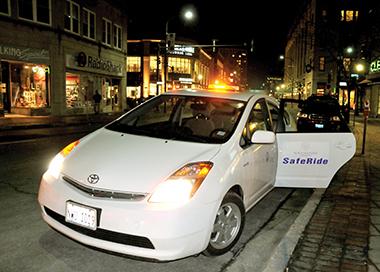Evanston officials: SafeRide shutdown never a possibility

Daily file photo by Sharon Paravastu
Evanston officials say SafeRide was never in danger of being shut down for violating city codes. The University said Tuesday it learned SafeRide might have violated a city ordinance if it continued to provide rides between off-campus sites.
April 18, 2014
Evanston officials say SafeRide was never in danger of being shut down for violating city codes, refuting claims the University made earlier this week as it defended its decision to stop offering rides between off-campus locations.
A senior NU official also admitted for the first time Thursday the University did not do enough to make sure students knew of the reduction in service, which quietly went into effect after Spring Break and was revealed on the first days of the quarter.
“The place that we did not do our due diligence really was developing an appropriate communications strategy for students in a timeframe that they could hear it and absorb it,” said Julie Payne-Kirchmeier, assistant vice president of student auxiliary services.
Associated Student Government mobilized against the new policy — SafeRide’s most drastic service change in years — and an online student petition against it garnered more than 600 signatures.
Payne-Kirchmeier responded Tuesday, saying the University learned SafeRide would violate a city ordinance if it continued to provide rides between off-campus sites. If the old policy were reinstated, the University would run the “risk of losing the SafeRide service all together,” she said.
That explanation left senior Evanston officials who work closely with the University scratching their heads.
“Where did the threat come from?” said Ald. Jane Grover (7th), whose ward includes most of the NU campus. “I can’t imagine we would want to have any role in shutting down SafeRide.”
City manager Wally Bobkiewicz on Wednesday confirmed SafeRide was never at risk of being shut down, at least from Evanston’s perspective. While the service SafeRide provides may fall under the city’s taxi ordinance, “it’s never come up as an issue” in talks between the city and University, he said.
In an interview Thursday, Payne-Kirchmeier stood by her letter to students, maintaining the decision was made because SafeRide was “creeping outside of its original intent” to safely transport students to and from campus. She also reiterated “there’s always a possibility” that programs operating in a legal gray area are at risk of getting shut down by authorities.
Payne-Kirchmeier traced the decision to late Fall Quarter, when, she said, SafeRide coordinator Bernard Foster talked to a staffer in the city manager’s office who said rides between two off-campus locations may be at odds with a city ordinance regarding taxi services.
Bobkiewicz said a SafeRide representative made a “cold call” to the civic center and spoke with a city staffer who is “not normally involved in discussions with the University on any subject.”
Foster was unavailable for comment for this story.
The discovery that SafeRide might be at odds with city law led Payne-Kirchmeier and Foster to revisit the original mission of the service. They then reached the decision to discontinue rides between off-campus locations, she said. The original plan, she said, was to implement the change in February along with the release of TapRide, a new app that allows students to request rides from their smartphones. Technical difficulties delayed the app’s introduction until the beginning of this quarter.
Payne-Kirchmeier said she regrets the timing of what followed: rolling out the policy change and the app immediately after Spring Break.
“I think that’s where we own it,” she said, admitting the University made mistakes. “We had done some verbal conversations with folks, and that wasn’t enough, so we’ll go back and circle back with ASG and figure out the best way to do that in the future.”
Student leaders from ASG regularly work with Payne-Kirchmeier and other University officials on new projects and policies — especially those that could affect a large swath of students. But outgoing ASG president Ani Ajith said he and his colleagues were surprised by the change.
“We don’t like it when we hear about something for the first time on Facebook and we’re caught off guard, not due to any incompetence on our part but a lack of communication from the University,” Ajith said.
In its first ASG meeting of the quarter, two days after the new off-campus policy went into effect, the Senate passed legislation asking the University to reverse its decision. On Thursday, Payne-Kirchmeier made it clear that the University has no intention to give in to these demands.
For Payne-Kirchmeier, the controversy is an opportunity to reassess students’ off-campus transportation needs, especially in regard to shuttles. She pointed out SafeRide wait times have decreased thanks to the changes this quarter, and although that was not the “primary decision driver” behind the elimination of rides between off-campus locations, she said it is a benefit.
Ajith does not believe the trade-off is worth it.
“This may reduce wait times but it leaves out a significant portion of the student population who need safe transport from location to location,” Ajith said. “We think this could have been handled better.”
Email: mc2014@u.northwestern.edu
Twitter: @Marshall_Cohen
Email: patricksvitek2014@u.northwestern.edu
Twitter: @PatrickSvitek


